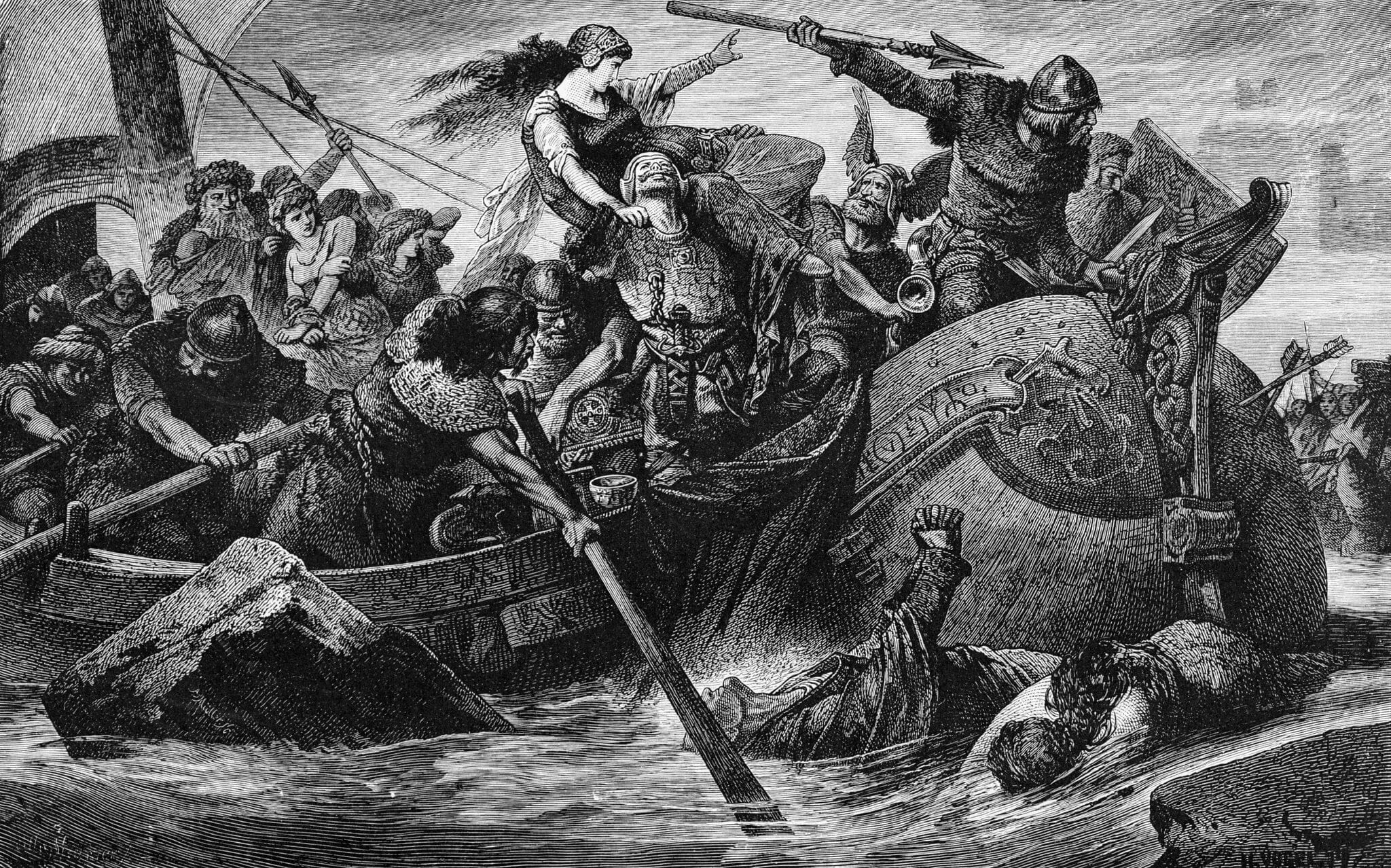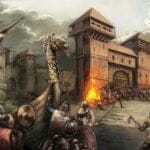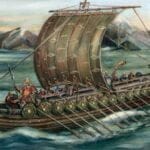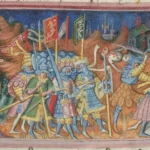Get ready for a thrilling trip back in time to the Viking Age, a mysterious period that left a lasting mark on our world. In this article, we’ll dig into the history books and uncover the secrets of this fascinating era. From their prowess as sailors to their complex society and the lasting impact they had on our world, join us on an immersive journey through time where the legacy of the Vikings continues to echo.
The Viking Age: When Norse Explorers Roamed
The Viking Age, a period stretching roughly from 800 to 1050 AD, likely evokes images of fearless Norse warriors sailing the seas. While these skilled seafarers from Scandinavia certainly engaged in raids and conquests, they were also explorers, traders, and settlers who left their mark far beyond their homelands.
The Spark that Ignited an Era
The famous attack on Lindisfarne in 793 AD is often cited as the beginning of the Viking Age. However, it’s probable that smaller-scale Viking voyages were already taking place before this momentous event. These early journeys paved the way for the larger expeditions that would come to define the Vikings. By the 9th century, Viking activity had reached a fever pitch.
More Than Just Raiders
The Vikings are often remembered for their fierce raids on coastal communities, and it’s true that they targeted places like England, Wales, and Ireland. However, their interactions with the lands they encountered were far more nuanced than simple plunder. The Vikings established settlements, engaged in local politics, and even intermarried with the people they encountered. Their impact on places like Ireland, for example, was profound, leaving a lasting mark on Irish culture and politics.
A Legacy That Lives On
While we talk about the “end” of the Viking Age, the influence of these seafarers didn’t simply vanish. Their settlements remained, their bloodlines mingled with local populations, and their cultural impact continued to shape the areas they’d explored. The Vikings’ journeys, both peaceful and warlike, played a role in shaping the political and cultural landscape of Europe and beyond, leaving a legacy that we still see echoes of today. To truly understand the profound impact of the Vikings, one must explore the fascinating realm of medieval Nordic architecture. This unique style blended Viking influences with Christian traditions, resulting in captivating structures that stand as testaments to this era. Furthermore, delving into the complex relationship between these religious institutions and the fierce Viking warriors by examining the Viking invasion on monasteries, provides a deeper understanding of the societal changes during that time.
When Did the Viking Age Start and End?
These legendary explorers didn’t just appear out of nowhere. Their era, what historians call the “Viking Age,” has fairly clear starting and ending points, though like with anything in history, those dates aren’t set in stone.
Most experts agree that the year 793 AD marks the beginning of the Viking Age. This was the year that a group of Norse raiders attacked the Lindisfarne monastery on the coast of England. Lindisfarne wasn’t just any random target; it was a holy site, a center of learning, and a symbol of power. The attack showed the world that the Vikings were a force to be reckoned with.
When it comes to the end of the Viking Age, things are a bit murkier. However, 1066 AD is widely accepted as the year it all drew to a close. This year saw the pivotal Battle of Hastings, where the Norman army, led by William the Conqueror (who, ironically, had Viking ancestry himself), clashed with the English forces. The Norman victory marked the end of Anglo-Saxon rule in England and, symbolically, the close of the Viking Age.
However, it’s important to remember that historical eras don’t have hard stops and starts. Even though these dates are used as bookends, the Vikings didn’t just disappear overnight. Viking influence continued to be felt across Europe and beyond. There are even some historians who argue that the Viking Age never truly ended, its legacy woven into the fabric of many cultures.
While 793 AD and 1066 AD give us a useful framework for understanding the Viking Age, it’s important to remember that history is a process, not just a collection of dates. The Vikings’ impact on the world was complex and long-lasting, extending far beyond those specific years.
Who Defeated the Vikings in History?
The Vikings sailed all over Europe for centuries, conquering, exploring, and trading. But even the mightiest warriors eventually meet their match. Let’s take a look at who finally put a stop to the Vikings’ reign of terror.
Anglo-Saxon Kingdoms: England’s Defenders
The Anglo-Saxon kingdoms of England faced the brunt of the Viking raids. King Alfred the Great, a true hero of his time, managed to unite these kingdoms, and his leadership proved crucial in the fight against the Vikings. In 878, at the Battle of Edington, Alfred’s forces delivered a decisive blow to the Viking invaders. This victory was a major turning point. While the Vikings didn’t completely disappear after Edington, their grip on England weakened considerably.
The Frankish Empire: A European Bulwark
Over in Western Europe, the Vikings encountered another formidable foe: the Frankish Empire. Under Charlemagne and his successors, the Franks were a force to be reckoned with. They boasted well-organized armies and strong fortifications.
Irish Resistance: A David and Goliath Story
The Vikings weren’t just active in England and mainland Europe; they also set their sights on Ireland. However, the Irish weren’t about to surrender their homeland without a fight. One name stands out in this struggle: Brian Boru, the High King of Ireland. He led the Irish to a legendary victory at the Battle of Clontarf in 1014, significantly weakening Viking influence in Ireland.
Scottish Fortifications: Holding the Line
The Vikings also tried their luck in Scotland, but the Scots, under the leadership of Kenneth MacAlpin, repelled Viking raids in the 9th century. Their strategy involved establishing fortified settlements and forming alliances with nearby kingdoms, essentially creating a united front against the invaders.
The End of an Era
It’s important to remember that the “defeat” of the Vikings wasn’t a single event but rather a gradual decline brought about by a combination of factors. The Vikings faced increasing resistance from well-organized forces, experienced cultural assimilation in some regions, and gradually transitioned from raiding and conquest to trading and settlement. Their legacy, however, lives on in the cultural tapestry of Europe and beyond.
Why Did the Age of Vikings End?
Like all good things, the Viking era eventually came to a close. A confluence of factors contributed to the end of the Viking Age. Let’s dive in and explore some of the most likely reasons.
1. Christianity Started Catching On
As Christianity slowly made its way through Scandinavia, it brought about a cultural shift. As more Vikings converted to Christianity, the old ways, including raiding and pillaging, became less appealing.
2. Scandinavia Started Squabbling Within
Instead of uniting for conquests abroad, different Viking factions found themselves entangled in power struggles and territorial disputes. These internal conflicts weakened them, diverting resources and attention away from their overseas expeditions.
3. The Normans Conquered England
The year 1066 marked a turning point. The Normans, with their advanced military strategies and technology, invaded England, a place where Vikings had established a strong foothold. The Vikings, once feared throughout Europe, were now being outmaneuvered and overtaken.
4. Technology Evened the Playing Field
Part of the Vikings’ success lay in their impressive shipbuilding and navigation skills. However, as time went on, other nations started catching up. They adopted and adapted shipbuilding and navigation techniques, eroding the technological advantage the Vikings had once enjoyed.
5. The Economy Shifted
Raiding and trading were the Vikings’ main sources of income. But, as with any economy, things changed. New trade routes emerged, and the centers of economic power shifted. These changes, combined with the decline of raiding due to the spread of Christianity, meant Vikings had to find new ways to prosper. Many turned to farming or other trades, shifting from a life of adventure to one of more settled existence.
So, What’s the Final Word?
The end of the Viking Age wasn’t a sudden event but a gradual transformation shaped by numerous factors. It’s a story of cultural shifts, internal conflicts, technological advancements, and economic changes. While their era of raiding and conquest might be over, their legacy lives on. We still see their influence in our language, our culture, and our understanding of that period of history. The Vikings remind us that even the mightiest empires are subject to change, and sometimes, the greatest journeys lead to unexpected destinations.
What is the Real Viking Age?
This period, stretching roughly from the late 700s to the mid-1000s, wasn’t just about Norse explorers setting sail; it was a complex tapestry of exploration, trade, conquest, and cultural exchange. These intrepid adventurers, driven by a mix of curiosity, ambition, and maybe even a bit of wanderlust, ventured out from Scandinavia to discover new lands, forge new alliances, and make their mark on the world.
While history often remembers the Vikings for their raids, there’s so much more to their story. They weren’t just fierce warriors; they were skilled craftspeople, clever traders, and surprisingly organized. Their metalwork, for example, was incredibly intricate, and their legal system was quite advanced for its time. They weren’t just plundering; they were establishing settlements, creating trade networks, and influencing the cultures they encountered.
One of the big questions historians are still trying to piece together is what exactly drove this era of expansion. It’s likely a combination of factors. Some experts believe that population growth in Scandinavia might have put a strain on resources, prompting people to seek new opportunities elsewhere. Others point to the political climate at the time, suggesting that internal conflicts and power struggles might have pushed some to look for a fresh start in a new land.
What we do know is that the Viking Age wasn’t just a blip on the historical radar. It left a mark that’s still visible today, not only in the historical records but also in the languages we speak, the stories we tell, and even our DNA. From place names that echo Norse origins to the enduring fascination with Viking mythology, their legacy continues to intrigue and inspire us centuries later.
Even with all the discoveries made, there’s still so much we’re learning about the Vikings. Archaeologists are constantly unearthing new artifacts and sites, and historians are reinterpreting old texts, which sometimes leads to new understandings of this complex period. The Viking Age is a reminder that history is rarely black and white; it’s a rich tapestry of interconnected events and motivations, and the more we uncover, the more fascinating it becomes.
Did Muslims Defeat Vikings?
While the Vikings were known for their lightning raids and impressive sailing skills, they weren’t invincible. They encountered a formidable opponent in the Iberian Peninsula: Muslim forces.
In 844 AD, a Viking fleet of 54 ships boldly sailed up the Guadalquivir River, setting their sights on Seville, which was part of the Umayyad Emirate of Córdoba, a powerful Muslim realm. The Vikings stormed the city, grabbing whatever loot they could get their hands on, but their victory was short-lived.
News of the attack reached the Emir of Córdoba, Abd ar-Rahman II, who wasted no time in gathering his troops. The Muslim army marched to meet the Vikings at a place called Talyata, and a fierce battle erupted. In the end, the Vikings were soundly defeated.
This victory was a major turning point, demonstrating the strength of the Muslim forces. The defeat at Talyata likely made other Viking crews think twice about raiding Muslim territories.
The raid on Seville had a lasting impact. It forced the Muslims to bolster their defenses, just in case the Vikings decided to come knocking again. They established a naval base in Seville itself and strengthened the fortifications of other coastal cities.
Here’s a quick recap:
- The Vikings did raid Seville in 844.
- The Muslim army, led by Emir Abd ar-Rahman II, crushed the Vikings at Talyata.
- The defeat at Seville probably deterred future Viking raids on Muslim territories.
- The Muslims learned a valuable lesson from the raid and beefed up their defenses to prevent future attacks.
Want to dive deeper? Check out “The Vikings in Spain: Conquest and Coexistence” by David Nicolle. It’s a fascinating read!
What Stopped the Viking Age?
The Vikings were all over the place for about three centuries, raiding, trading, and even establishing settlements far and wide. But by the late 11th century, their era of epic voyages and conquests was pretty much over. It’s likely that a number of factors contributed to their decline.
They Faced Stiffer Competition
By the 11th century, the kingdoms they once raided – places like England and France – had become a lot more organized and powerful. They were better at defending themselves, making those Viking raids a lot less profitable and a lot riskier.
Religion Played a Role, Too
As Christianity spread throughout Scandinavia, it started to change things. Many Vikings converted, and the old justifications for raiding – those stories about winning favor from the Norse gods through battle and plunder – well, they didn’t hold the same weight anymore.
Internal Squabbles Didn’t Help
As time went on, different Viking factions started battling amongst themselves for power and control. All that infighting definitely weakened them and made it harder to focus on those big expeditions overseas.
And Then There’s the Climate…
Some historians believe that even the weather turned against the Vikings. Some studies suggest that colder temperatures made farming tougher, which could’ve pushed people to seek better living conditions elsewhere, maybe even causing some to abandon their traditional seafaring ways.
Keeping Up With the Joneses
The Vikings were known for their awesome ships and sailing skills, but other European countries were paying attention. They began adopting and even improving upon Viking shipbuilding techniques. So, that technological edge the Vikings once had began to fade, making it tougher for them to dominate the seas like they used to.
Here’s the Catch, Though…
We can’t say for certain what single-handedly brought the Viking Age to an end. History is complex! It was likely a mix of all these factors, each playing a part in weaving the story of the Vikings’ decline.
Who Came After the Vikings?
It wasn’t just one group that took center stage.
The Anglo-Saxons
The Anglo-Saxons were already living in England, even before the Vikings showed up. As the Viking Age faded, they strengthened their hold on England, mixing some Viking ways into their own culture. They embraced Christianity, creating this unique blend of Scandinavian and Anglo-Saxon flavors.
The Normans
Some Vikings liked France so much they decided to stay. They became the Normans! And in 1066, led by William the Conqueror, they invaded England. The Normans introduced their own feudal system and ideas about how to run a country, which significantly impacted English society.
The Slavs
Meanwhile, over in Eastern Europe, the Slavs were making a name for themselves. They were expanding their territories, setting up strong kingdoms like Kievan Rus’ (sound familiar, Russia?) and the Kingdom of Poland. They were a force to be reckoned with, spreading their influence across Eastern Europe and beyond.
So, in a nutshell:
- Anglo-Saxons: Reasserted control in England, blending Viking traditions with their own.
- Normans: Conquered England, bringing their own brand of feudalism and governance.
- Slavs: Rose to prominence in Eastern Europe, establishing powerful kingdoms.
It’s important to remember that history is rarely neat and tidy. While we often talk about distinct groups, there was a lot of interaction and mixing between them. People moved around, ideas spread, and cultures blended. The period after the Vikings was a time of significant change and development, setting the stage for the Europe we know today.
Is Ragnar Lothbrok Real?
Ragnar Lothbrok, a guy who seems to pop up everywhere in Viking history. But figuring out if he was an actual person or just a cool story is tricky!
We know for a fact that his sons, guys like Ivar the Boneless, Ubbe, and Bjorn Ironside, were the real deal. These weren’t just any Vikings; they were leading raids all over England and France in the late 800s AD, shaking things up and leaving their mark on history. Their existence makes you wonder, “If the sons were this famous, what about their dad?”
The Ragnar we meet in those epic sagas is a rockstar! He’s brave, clever, and always leading daring adventures. But the problem is, these sagas are like really juicy historical gossip – fun to listen to, but not always the most reliable.
Archaeologists are like detectives, digging up clues about the Vikings. They’ve found rune stones, buried ships, and even whole Viking villages! This stuff proves that the Viking Age was a wild time, full of adventure and conquest, just like the stories say.
Even if we can’t definitively say “Yep, Ragnar Lothbrok walked the earth,” his impact is undeniable. He’s a symbol of the Viking spirit – brave, adventurous, and a little bit wild. Whether he was one guy or a blend of a bunch of legendary figures, his story keeps inspiring us centuries later.
Here’s the lowdown:
- We still debate if Ragnar was a real person or a legendary figure.
- His sons, though, were absolutely real and totally rocked the Viking world.
- Ragnar’s epic adventures are likely a mix of real events and some creative storytelling.
- Archaeological finds confirm that the Vikings were a force to be reckoned with, just as the stories suggest.
- Whether fully real or a blend of legends, Ragnar’s impact on how we imagine the Vikings is undeniable.
Want to dive deeper? There are tons of books and articles about the Vikings and the mystery of Ragnar Lothbrok. Keep exploring!
Were Vikings Around 2000 Years Ago?
When historians talk about the “Viking Age,” they’re usually referring to a period between the late 8th century and the late 11th century AD. That’s roughly 1200 years ago, not 2000.
Now, while it’s unlikely Vikings were around 2000 years ago as we typically understand them, Scandinavia definitely had its share of activity back then. The people living there before the Viking Age weren’t just sitting around. They had their own rich cultures and traditions, and it’s likely some of their ways of life influenced the Vikings who came later.
What Language Did Vikings Speak?
The Vikings spoke Old Norse. Old Norse itself came from a language called Proto-Norse, which came from Proto-Germanic – the ancient ancestor of a huge family of languages including English, German, and yes, even Old Norse!
Just like families can have regional accents, Old Norse wasn’t spoken exactly the same way everywhere. There were different dialects with their own quirks of pronunciation, grammar, and even the words they used.
If you were to travel back in time and listen in on a Viking longhouse gathering, you’d hear stories of brave heroes and mythical gods, all passed down through the generations in Old Norse. These weren’t just campfire tales, either – they wrote down their sagas, poems called Eddas, and myths in this very language. It was their way of preserving their history, beliefs, and culture.
The influence of Old Norse didn’t just disappear after the Viking Age, though. It left its mark! Think about English – words like “berserk,” “skull,” and even “Thursday” (originally “Thor’s Day”) all have roots in Old Norse. And of course, if you’re ever in Iceland, you’ll notice that Icelandic sounds remarkably similar to Old Norse.
But it’s not just English and Icelandic that owe a debt to Old Norse. Languages like Swedish, Norwegian, and Danish all bear traces of their shared linguistic heritage. It’s pretty amazing to see how a language spoken over a thousand years ago still echoes in the way we communicate today.
While we have a good grasp of Old Norse from written records, researchers are always digging deeper, exploring those regional dialects, and trying to understand how the language changed over time.
- Unlocking Francis Alexander Shields’ Finance Empire: A Comprehensive Biography - July 12, 2025
- Unveiling Francis Alexander Shields: A Business Legacy - July 12, 2025
- Francis Alexander Shields’ Business Career: A Comprehensive Overview - July 12, 2025















